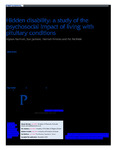Hidden disability: a study of the psychosocial impact of living with pituitary conditions
| dc.contributor.author | Norman, Alyson | |
| dc.contributor.author | Jackson, S | |
| dc.contributor.author | Ferrario, H | |
| dc.contributor.author | McBride, P | |
| dc.date.accessioned | 2022-08-15T10:53:17Z | |
| dc.date.available | 2022-08-15T10:53:17Z | |
| dc.date.issued | 2022-06-09 | |
| dc.identifier.issn | 0966-0461 | |
| dc.identifier.issn | 2052-2819 | |
| dc.identifier.uri | http://hdl.handle.net/10026.1/19533 | |
| dc.description | Slight change to title made prior to publication. | |
| dc.description.abstract |
Background: Pituitary patients often experience psychosocial symptoms associated with their condition. Aims: To explore the condition management experiences of pituitary patients and their psychosocial symptoms and to explore the impact of these on quality of life. Methods: A sample of 748 individuals aged 18 to more than 65 years) completed a questionnaire relating to quality of life and the psychosocial impact of pituitary conditions. Findings: Analysis of the qualitative sections using content analysis identified four themes: social isolation, emotional and behavioural issues, appearance distress and physical and cognitive effects including fatigue and pain. An overarching theme of hidden disability emerged. Conclusion: The study identified multiple biopsychosocial factors that impact quality of life, with symptoms not visible to others most likely to impact negatively. Nurses are well placed to provide support and information to patients about the possible psychosocial impact of pituitary conditions to enable positive adjustment. | |
| dc.format.extent | 590-597 | |
| dc.format.medium | ||
| dc.language | en | |
| dc.language.iso | eng | |
| dc.publisher | Mark Allen Group | |
| dc.subject | Long-term conditions | |
| dc.subject | Pituitary gland conditions | |
| dc.subject | Psychosocial effects | |
| dc.subject | Quality of life | |
| dc.subject | Fatigue | |
| dc.subject | Humans | |
| dc.subject | Pain | |
| dc.subject | Palliative Care | |
| dc.subject | Qualitative Research | |
| dc.subject | Quality of Life | |
| dc.subject | Surveys and Questionnaires | |
| dc.title | Hidden disability: a study of the psychosocial impact of living with pituitary conditions | |
| dc.type | journal-article | |
| dc.type | Journal Article | |
| plymouth.author-url | https://www.ncbi.nlm.nih.gov/pubmed/35678809 | |
| plymouth.issue | 11 | |
| plymouth.volume | 31 | |
| plymouth.publication-status | Published | |
| plymouth.journal | British Journal of Nursing | |
| dc.identifier.doi | 10.12968/bjon.2022.31.11.590 | |
| plymouth.organisational-group | /Plymouth | |
| plymouth.organisational-group | /Plymouth/Faculty of Health | |
| plymouth.organisational-group | /Plymouth/Faculty of Health/School of Psychology | |
| plymouth.organisational-group | /Plymouth/REF 2021 Researchers by UoA | |
| plymouth.organisational-group | /Plymouth/REF 2021 Researchers by UoA/UoA04 Psychology, Psychiatry and Neuroscience | |
| plymouth.organisational-group | /Plymouth/Research Groups | |
| plymouth.organisational-group | /Plymouth/Research Groups/Centre for Brain, Cognition and Behaviour (CBCB) | |
| plymouth.organisational-group | /Plymouth/Research Groups/Centre for Brain, Cognition and Behaviour (CBCB)/Behaviour | |
| plymouth.organisational-group | /Plymouth/Users by role | |
| plymouth.organisational-group | /Plymouth/Users by role/Academics | |
| dc.publisher.place | England | |
| dcterms.dateAccepted | 2021-11-01 | |
| dc.rights.embargodate | 2022-12-9 | |
| dc.identifier.eissn | 2052-2819 | |
| dc.rights.embargoperiod | Not known | |
| rioxxterms.versionofrecord | 10.12968/bjon.2022.31.11.590 | |
| rioxxterms.licenseref.uri | http://www.rioxx.net/licenses/all-rights-reserved | |
| rioxxterms.type | Journal Article/Review |


